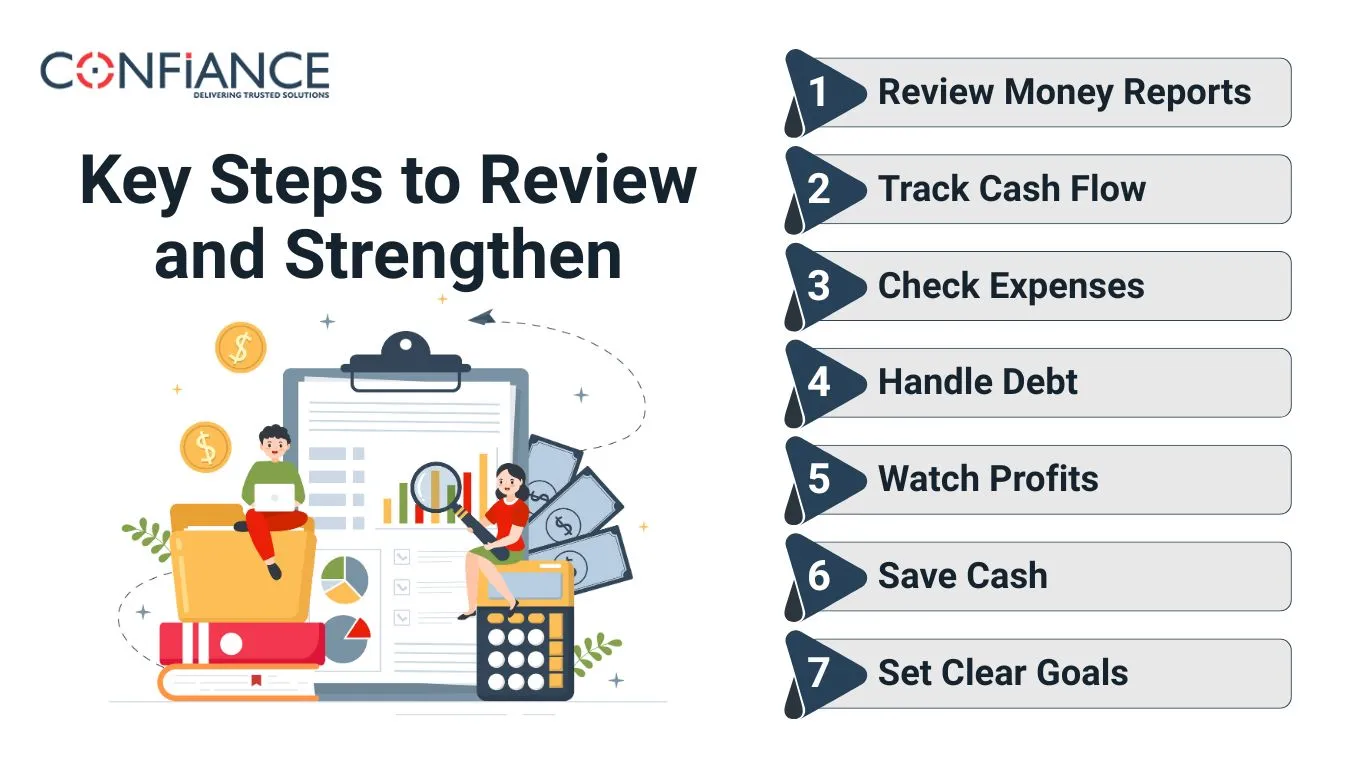
Steps to Review and Strengthen Your Company’s Financial Health
Every business needs strong financial health. It shows how well your company earns, spends, and grows. Good financial status helps you pay bills on time, invest in new work, and handle hard times. Check your money often to spot problems early and fix them fast. This guide gives simple steps to review and strengthen your company’s financial health.
Understanding Your Current Financial Health
Before you change things, you must know where you stand. A clear view of your money shows what works and what needs fixing.
Check Your Money Reports
Money reports tell the story of your company. Focus on:
- Income Statement: Shows how much money comes in and goes out each month.
- Balance Sheet: Lists what you own and what you owe at a given time.
- Cash Flow Report: Tracks cash moving in and out every month.
Read these reports carefully. They show where your company earns profit and where it loses money. Strong financial status starts here.
Use Simple Ratios
Ratios help you see your company’s strength. Watch these:
- Cash Ratio: Can you pay bills fast?
- Profit Ratio: How much do you earn from sales?
- Debt Ratio: How much money do you owe?
Track these numbers often. They show how your financial health changes over time.
Key Steps to Review and Strengthen
Improving financial health needs clear, simple steps. Follow these steps to check and boost your company’s money and stability.
Step 1: Review Money Reports
Look at your income, spending, and cash flow reports. See what money comes in, what goes out, and how much you have on hand. This gives a clear start for changes.
Step 2: Track Cash Flow
Watch all the money coming in and going out. Find times when cash is low or used too fast. Make sure cash is enough to pay bills and keep the business running.
Step 3: Check Expenses
List all costs and see which are needed. Cut spending that is not important. Ask suppliers for better deals. Reduce waste but keep work going well.
Step 4: Handle Debt
List all debts and the rates you pay. Pay off loans with high rates first. Avoid taking new loans that do not help the company.

Step 5: Watch Profits
Check profit often. See which products or services earn less. Change prices, cut costs, or focus on items that earn more to grow your income.
Step 6: Save Cash
Set aside funds for extra costs or crisis events. A safety fund helps keep the business safe and stable when challenges occur.
Step 7: Set Clear Goals
Set clear, simple goals for income, profit, and savings. Check progress often and adjust plans to keep money healthy and strong.
Common Challenges in Maintaining Strong Financial Health
Many firms face problems that can weaken their financial health.
Cash Flow Issues
Late payments or high costs can leave money low. Watch money in and out to avoid shortfalls and keep the firm running.
Rising Costs
Extra costs for rent, power, or goods cut profit. Track spending closely and cut waste to keep money safe.
Too Much Debt
High loans bring high interest. Pay off loans on time and avoid new debt that does not help.
Poor Budgeting
Without a clear plan, money may be spent the wrong way. Simple budgets help track costs and keep the firm strong.
Low Profit Growth
Flat sales or low gains hurt the bottom line. Focus on high-gain items, cut costs, or boost sales to make money.
Sudden Costs
Repairs, fines, or legal fees may happen. Keep some money saved to cover these events and stay safe.
Few Income Sources
Relying on a few buyers or items is risky. Add more ways to earn to spread risk and keep money steady.
Messy Records
Inaccurate or unclear notes make it hard to track money and plan. Keep simple, up-to-date records to stay in control.
Key Metrics to Track for Financial Health
Watching the right numbers shows how healthy your business's money is.
Cash Ratio
Shows if you can pay short-term bills. Higher values mean more cash on hand.
Profit Margin
Shows how much of your sales become profit. Tracking this helps find strengths and weak spots.
Debt-to-Income Ratio
Compares debt to income. Low numbers show better stability and strong money health.
Accounts Receivable Turnover
Tracks how fast clients pay. Faster payments give more cash and lower stress on money flow.
Current Ratio
Shows short-term money strength. A number over one means enough assets to pay debts.
Return on Investment (ROI)
Shows gains from projects or spending. Positive ROI helps grow money and keeps finances strong.
Watching these numbers often keeps your money healthy, clear, and easy to measure.
Best Practices for Sustaining Money Health
Follow simple habits to keep your money strong and your business safe.
Check Money Often
Look at reports, cash flow, and budgets each month. Spotting small issues early stops them from growing.
Track Income and Costs
Keep clear notes. Watching daily money in and out helps see trends and find areas to improve money health.
Cut Unneeded Spending
Trim costs that are not needed without harming work. This keeps profit and savings strong.
Save for Emergencies
Keep money aside for sudden events. A safety fund keeps the business safe when surprises happen.
Plan Smart Investments
Pick projects that give high returns. Avoid low-value spending to keep money safe.
Involve Key Team Members
Share money goals and progress with partners or managers. Working together boosts control and results.
Planning for Growth and Investment
Good money and health let your business grow safely.
Set Clear Growth Goals
Pick clear targets for sales and profit. Simple goals help guide plans and the use of funds for safe, steady growth.
Check Opportunities
Look at new markets, products, or services. Focus on options that grow money and add long-term value.
Plan Expansion Budget
Set funds for staff, tools, or marketing. Smart budgeting stops overspending and keeps the business stable.
Forecast Cash Needs
Estimate the cash you will need for growth. Careful planning lowers the risk of money shortfalls or delays in work.
Weigh Risk and Reward
Check possible risks before you spend. Balance risk and reward to keep money healthy and strong over time.
Track Investment Results
Watch returns from projects. Learn from what works and what does not to plan better in the future.
Preparing for Financial Uncertainty
Strong money health helps a business survive risks and shocks.
Build a Safety Fund
Save money to cover 3–6 months of costs. A safety fund keeps the business safe in slow periods.
Use Insurance
Insurance shields against harm, accidents, or claims. This keeps the business secure in unexpected events.
Spread Income Sources
Relying on one customer or product is risky. Multiple ways to earn, reduce risk, and keep cash steady.
Plan for Scenarios
Think ahead and make plans for risks. Being ready helps the business stay safe and strong.
Cut Short-Term Debt
Pay off high-rate loans before uncertain times. Less debt lowers stress on cash flow and keeps money stable.
Track Key Numbers
Check main numbers often to spot trends. Seeing problems early lets you act fast to keep money, health, and strength.
Strong money health keeps your business safe, earns profit, and allows growth. Following clear steps, tracking key numbers, planning growth, and preparing for risks helps your company thrive. With the right support, your money and health can stay strong now and in the future.
At Confiance, we give services that keep your money strong. Our certified team makes it easy to track cash flow and see money in and out. We make clear reports on sales, costs, and profit so you can see how your business works. We make plans to cut debt, lower loan costs, reduce waste, and grow with smart moves. Our work lowers risk and keeps growth safe and steady. Partner with us to grow your business safely and steadily.
FAQs
- What is money health, and why is it key?
Money health shows how well a company earns, spends, saves, and grows money. It is key because it keeps the business safe, allows growth, and helps face surprises. - How often should I check my company’s money health?
Check your money health each month. Regular checks spot problems early, track progress, and keep the business stable. - What are the main steps to boost money health?
Steps include checking reports, managing cash, cutting waste, controlling debt, saving funds, and setting clear money goals. - How can small changes improve money health?
Small steps like checking daily income, cutting small costs, and planning cash use can help keep money safe and the business steady.
- Which numbers are most important to watch?
Cash ratio, profit margin, debt-to-income ratio, accounts receivable turnover, and ROI are key numbers to track money health. - How do I get ready for money risks?
Save an emergency fund, use multiple income sources, get insurance, reduce high-rate debt, and plan for risks. Being ready keeps money, health strong. - How can I keep money healthy and strong for the long term?
Watch income and costs, check reports often, cut unneeded spending, pick smart projects, and involve your team to keep money safe and strong.
- What is the easiest way to spot money problems early?
Check cash flow and spending each week. Watch for gaps, overdue payments, or low funds. Early checks help fix problems fast and keep finances safe.
